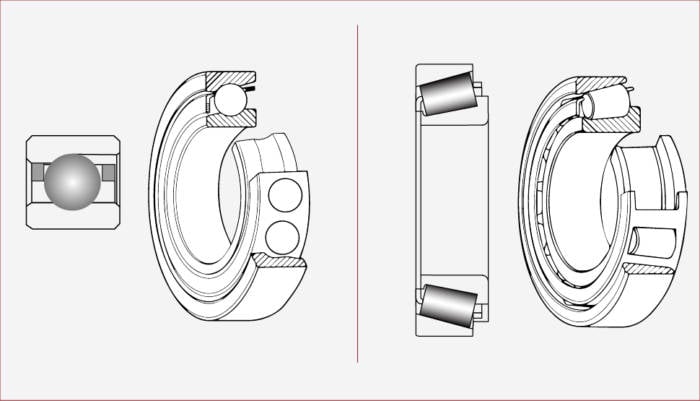Spindle Bearing Types: Roller, Angular, Radial & More

Spindles are the heart of each and every machine tool, from the aerospace industry to automotive and medical equipment manufacturing. They can come in a variety of different sizes and are capable of many different applications. Inside each spindle is a set of bearings that must hold very tight tolerances, withstand extreme conditions, and last for many years. As such, there are different types of bearings manufactured for very specific applications.
Types of Spindle Bearings
Spindle bearings are categorized into the following types:
Roller Bearings
Roller bearings support rotation through the use of rolling cylinders instead of balls. They are used to support primarily radial loads parallel to the axis in one direction. They can be used in low speed/high load to high speed/light load applications.
Angular-Contact Ball Bearings
Angular-contact ball bearings consist of rolling balls between concentric grooved races. This type of bearing is useful for withstanding combined loads (radial and axial). The greater the angle, the higher the load capacity of the bearing in an axial direction. Angular-contact ball bearings are one of the most common spindle bearings.
Radial or Deep Groove Bearings
Radial bearings are primarily used for load bearing on the radial axis. Similar to angular contact ball bearings, radial bearings feature an inner and outer race with rolling balls between them. The difference is that radial bearings can bear loads in both axial directions. This makes them useful for more applications than angular-contact bearings.
Thrust Bearings
Thrust ball bearings are specifically designed to support heavy, high precision thrust loads. They offer precise axial support parallel to the shaft, but little to no radial support. Depending on the application, the rolling element could be a ball, roller, or needle.
Hydrostatic/Hydrodynamic Bearings
Hydrostatic and hydrodynamic spindles have very good radial accuracy. However, they have disadvantages in terms of rigidity and purchasing costs compared to spindles with roller bearings.
In hydrostatic spindles, the shaft is guided by an externally generated static oil pressure within the oil pockets in the glide elements. Therefore, an additional hydraulic system is required for operation of the hydrostatic spindle. Hydrodynamic spindle design is based on the physical principle of fluid friction, in which the bearing load capacity is created by shaft rotation.
Air Bearings
In an air bearing spindle, a cushion of air carries the load without any contact between the moving parts. The air is usually supplied by a compressor; the goal is for the stiffness and damping of the air cushion to reach the highest possible level. Air consumption and uniformity of air supply into the gap are crucial for the behaviors of air bearings.
Air is delivered to the gap by various means:
- Porous surface
- Partial porous surface
- Discrete orifice feeding
- Slot feeding
- Groove feeding
Spindle Bearing Selection
When we are repairing any type of spindle at Northland Tool, we use exact replacements for the bearings found in the spindle (after confirming the current bearings are rated for the spindle specifications). However, there are occasionally a few factors that we need to consider for possible improvements or upgrades, including:
- Available space in the housing
- Cutting loads (magnitude and direction)
- Precision and stiffness of the bearings
- Operation speeds
- Operating temperature
- Vibration levels
- Potential sources of contamination
- Mounting and seal requirements
If you have any questions about replacing or upgrading the bearings in your spindle, reach out to the team at Northland Tool today — we’ve got the experience and expertise to guide you.
- Machine Tool Spindle Bearing Lubrication: What To Know
- Delaying Spindle Service Causes More Damage, Costly Repairs
- What Does It Mean to Be a Factory Authorized Big Plus Spindle Rebuilder?
- Precision Machining in a World of Microns
- GPG: Grind-Plate-Grind Process Explained
- What Is the Spindle Repair Process?
